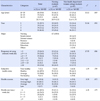Abstract
Purpose
The aim of this study was to investigate e-health literacy and self-care agency of nursing students and non-health department women college students.
Methods
A descriptive comparative design was used. Participants were 67 nursing students and 67 non-health department women college students between 18 and 25 years old from a university located in Seoul. Data collection was done from September 2 to October 5, 2016 using structured questionnaires. Data were analyzed using independent t-test, χ2 test, ANCOVA, ANOVA, Scheffé test, and Pearson's correlation coefficients with SPSS 23.0.
Results
e-Health literacy had significant difference (F=1.95, p<.018) between nursing students and non-health department women college students. However, self-care agency was not significantly different (F=1.05, p=.426). There were significant positive correlation (r=.63, p<.001) in e-health literacy and self-care agency of nursing students.
Figures and Tables
Table 1
The General Characteristics of Nursing Students and Non-health Department Women College Students (N=134)

Table 2
Difference in e-Health Literacy between Nursing and Non-health Department Women College Students (N=134)

Table 3
Difference in Self-care Agency between Nursing and Non-health Department Women College Students (N=134)

References
1. Stellefson M, Hanik B, Chaney B, Chaney D, Tennant B, Chavarria EA. eHealth literacy among college students: A systematic review with implications for ehealth education. J Med Internet Res. 2011; 13(4):e102. DOI: 10.2196/jmir.1703.
2. Park SS, Lee SJ, Hahm YK, Gustafson D. Study on relationship of patients information need, e-Health system use and outcomes: CHIS system in patients with breast cancer center. J Inf Syst. 2013; 22(2):105–129. DOI: 10.5859/kais.2013.22.2.105.
3. Kim JY, Cho CH, Jang SJ, Youn EJ. 2015 survey on the internet usage. Research Report. Seoul: Korea Internet & Security Agency;2015. 12.
4. KISA Internet Statistics Information Retrieval System. 2015 Internet use worldwide [Internet]. Seoul: Korea Internet & Security Agency;2016. cited 2017 March 2. Available from: http://isis.kisa.or.kr/statistics/?pageId=050300.
5. Kim SJ, Jung EY. A relevance on health perception, health knowledge and health promotion behavior of the university students. J Korea Acad Ind Coop Soc. 2015; 16(8):5394–5403. DOI: 10.5762/kais.2015.16.8.5394.
6. World Health Organization (WHO). eHealth [Internet]. Geneva: WHO;2016. cited 2017 March 10. Available from: http://www.who.int/ehealth/en/.
7. Norman CD, Skinner HA. eHEALS: The ehealth literacy scale. J Med Internet Res. 2006; 8(4):e27. DOI: 10.2196/jmir.8.4.e27.
8. Neter E, Brainin E. eHealth literacy: Extending the digital divide to the realm of health information. J Med Internet Res. 2012; 14(1):e19. DOI: 10.2196/jmir.1619.
9. Tubaishat A, Habiballah L. eHealth literacy among undergraduate nursing students. Nurse Educ Today. 2016; 42:Supplement C. 47–52. DOI: 10.1016/j.nedt.2016.04.003.
10. Kim NS, Lee KE, Son HJ. Comparison of health consciousness and smart-phone literacy according to the type of health information seeking behavior on the internet among one university students. J Health Inform Stat. 2016; 41(1):112–122. DOI: 10.21032/jhis.2016.41.1.112.
11. Park H, Lee E. Self-reported eHealth literacy among undergraduate nursing students in South Korea: A pilot study. Nurse Educ Today. 2014; 35:408–413. DOI: 10.1016/j.nedt.2014.10.022.
12. Lauder W. The utility of self-care theory as a theoretical basis for self-neglect. J Adv Nurs. 2001; 34(4):545–551. DOI: 10.1046/j.1365-2648.2001.01784.x.
13. Mohammadpour A, Rahmati Sharghi N, Khosravan S, Alami A, Akhond M. The effect of a supportive educational intervention developed based on the Orem's self-care theory on the self-care ability of patients with myocardial infarction: A randomised controlled trial. J Clin Nurs. 2015; 24(11-12):1686–1692. DOI: 10.1111/jocn.12775.
14. Ören B, Zengin N, Gül A. Determination of the self-care agency levels in Turkish nursing students. In : Honor Society of Nursing, Sigma Theta Tau International 24th International Nursing Research Congress; 22 July, 2013; Prague, Czech Republic. Available from: https://stti.confex.com/stti/congrs13/webprogram/Paper5 6374.html.
15. Lee SM. Factors affecting the health promoting behaviors of health-related and health-unrelated department university students. J Korea Acad Ind Coop Soc. 2015; 16(9):6120–6129. DOI: 10.5762/KAIS.2015.16.9.6120.
16. Suziedelyte A. How does searching for health information on the internet affect individuals' demand for health care services. Soc Sci Med. 2012; 75(10):1828–1835. DOI: 10.1016/j.socscimed.2012.07.022.
17. Ashcraft PF, Gatto SL. Care of self in undergraduate nursing students: A pilot study. Nurs Educ Perspect. 2015; 36(4):255–256. DOI: 10.5480/13-1241.
18. So HS. Testing construct validity of self-as-carer inventory and its predictors. J Korean Acad Soc Home Care Nurs. 1992; 4(2):147–161.
19. Park DJ, Kwon MS, Choi JH. The influence of health information orientation, attitude of internet health information, and e-Health literacy on personal health behaviors. J Public Relat Res. 2013; 17(3):379–431.
20. Perazzo J, Reyes D, Webel A. A systematic review of health literacy interventions for people living with HIV. AIDS Behav. 2017; 21(3):812–821. DOI: 10.1007/s10461-016-1329-6.
21. Lee BK, Byoun WJ, Lim JL. The influence of individual's ehealth literacy on doctor-patient communication. J Cybercommunication Acad Soc. 2010; 27(3):89–125.
23. Lim WR. Research concerning the influence personal e-health literacy has on the reliability of on-line medical information. [masters thesis]. Seoul: Hanyang Univeristy;2014.
23. Geden E, Taylor S. Construct and empirical validity of the selfas-carer inventory. Nurs Res. 1991; 40(1):47–50.
24. Stark MA, Hekstra T, Hazel DL, Barton B. Caring for self and others: Increasing health care students' healthy behavior. Work. 2012; 42(3):393–401. DOI: 10.3233/WOR-2012-1428.
25. Park HJ, Park HM. eHealth literacy skills among undergraduate nursing students in the U.S. and South Korea. Stud Health Technol Inform. 2016; 225:899–900. DOI: 10.3233/978-1-61499-658-3-899.
26. Kim SJ. An exploratory study of undergraduates' health information needs and seeking behaviors in social media. J Korean Biblia Soc Lib Inf Sci. 2012; 23(4):239–260. DOI: 10.14699/kbiblia.2012.23.4.239.
27. American Association of College of Nursing. The essentials of baccalaureate education for professional nursing practice [Internet]. Washington, DC: American Association of College of Nursing;updated October 20, 2008. cited March 2, 2017. Available from: http://www.aacnnursing.org/Portals/42/Publications/BaccEssentials08.pdf.
28. American Nurses Association. Healthy nurse, healthy nation. Silver Spring: American Nurses Association;2013. cited March 2, 2017. Available from: www.nursingworld.org/MainMenuCategories/WorkplaceSafety/Healthy-Nurse.
29. Kim H. Comparison of health behavior, stress and stress coping type between undergraduate nursing students and female students in other majors. J East West Nurs Res. 2015; 21(1):28–35. DOI: 10.14370/jewnr.2015.21.1.28.
30. Rice RE. Influence, usage, and outcomes of internet health information searching: Multivariate results from the Pew surveys. Int J Med Inf. 2006; 75(1):8–28. DOI: 10.1016/j.ijmedinf.2005.07.032.




 PDF
PDF ePub
ePub Citation
Citation Print
Print




 XML Download
XML Download